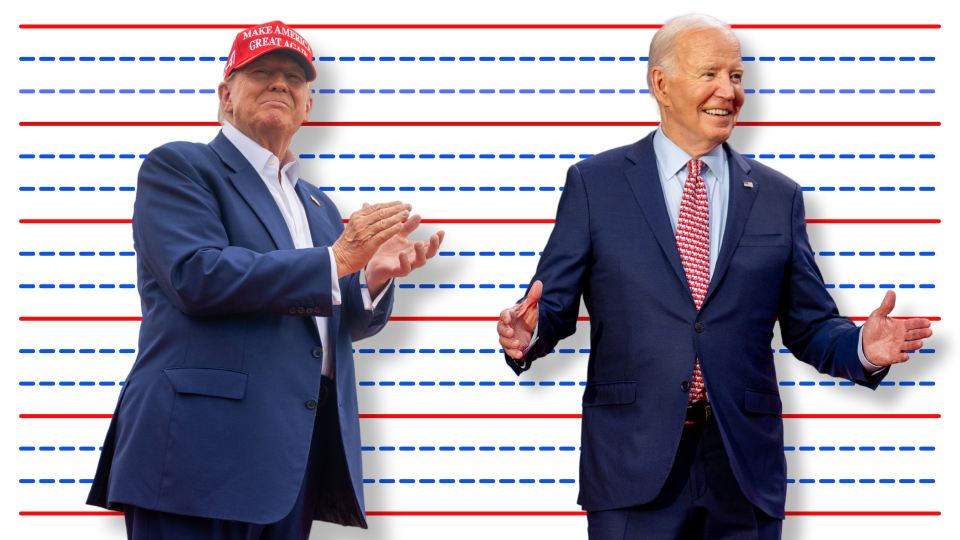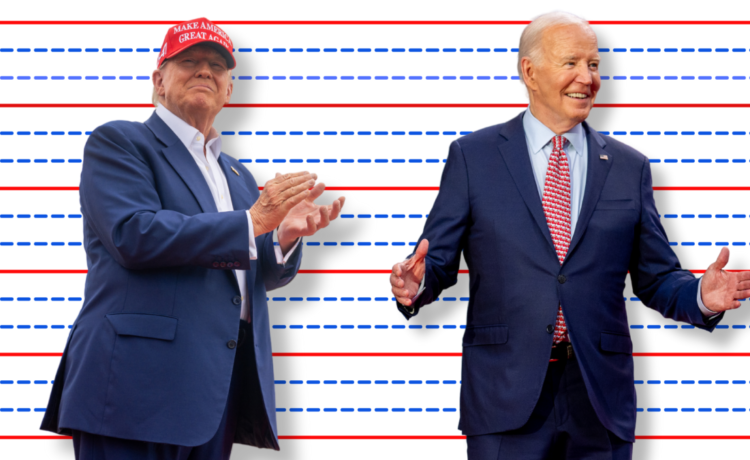Joe Biden and Donald Trump are set to lay out very different summaries of recent history when they meet Thursday for their first debate.
These dueling economic narratives are much more than academic. Which version of the last seven and a half years voters believe could very well decide the winner this fall.
To help cut through the spin, Yahoo Finance is offering a way to test what you know about five key aspects of the economic records of the current president and his immediate predecessor.
How much did inflation go up in each administration? How much job creation did each man oversee? Who pumped more oil? Who increased the national debt the most? Who was the bigger trade warrior?
Click on one of the above if you want to jump ahead. But before you guess, keep in mind that both campaigns have spent months now offering an oversimplified version of events.


Take the subject of inflation. Trump is likely to focus on prices when he takes the debate stage in Atlanta. If his rhetoric at nearly every campaign stop is prologue, he will note the large rise in prices since Biden took office and say inflation is “rampaging.”
The charge is true, but Trump often inflates the number beyond recognition and always overlooks the much cooler inflation readings since 2022 — not to mention the much more modest price increases during Trump’s own term.
Biden is likely to respond by noting that the US has gained over 15 million jobs since he took office and that Trump is the first president to lose a net number of jobs since Herbert Hoover.
That is true but also overlooks the COVID-era shutdown of the US economy that scrambled the labor market as Biden took the reins.
See if you can cut through the rhetoric of both candidates:
How much did inflation go up?
The central economic issue of the campaign is inflation. The high stakes have led to false claims from both sides.
Trump has a clear advantage on the issue but has often seemed to pull numbers out of thin air. In one recent comment, he charged that inflation “takes away 30% to 50% of every dollar you have.”
Biden has tended to stick closer to the facts but sometimes offers his own exaggerations. In a recent interview with Yahoo Finance, for example, he repeated a false claim that inflation “was at 9% when I came in.”
Both claims are wrong.
Prices are now up about 20% in total since Biden was sworn into office. For comparison’s sake, prices rose just under 7.8% during the four years of Trump’s presidency.
The year-over-year inflation rate when Biden took office was 1.4%, not 9%. Though prices did reach 9.1% in June 2022.
The latest data pegs the current year-over-year inflation rate at 3.3% in May, a downtick from a 3.4% rate in April.
How many jobs did Trump and Biden create?
Job creation is another issue at the center of the 2024 economic conversation, with the labor market taking a volatile ride in recent years.
The US economy steadily added jobs for the first three years of the Trump administration. This was a continuation of a trend seen under Barack Obama, Trump’s immediate predecessor.
The labor market then faced severe disruptions with the coming of the COVID-19 pandemic in 2020. The economy was shut down and more than 20 million jobs were lost in a single month.
The jobs market then began a multiyear recovery, and Biden took office in the early stages of that process. Biden has now overseen a US jobs recovery that surpassed pre-COVID levels to reach new all-time highs.
Who pumped more oil?
Energy is another oft-discussed 2024 topic. Trump has taken to saying that Biden “crushed” the oil industry, and the Republican is promising to make it a day-one priority if he wins.
But the story of US crude oil production over the last eight years isn’t quite so simple.
The US is currently producing more oil than any other country in history. This is — perhaps ironically — an inconvenient detail for both Trump and Biden.
For Trump, it cuts against his often repeated (and false) claim that the United States under Biden has “ended oil exploration and production.” It hasn’t and, by some measures, Biden’s granting of oil drilling permits is outpacing even Trump.
For Biden, overseeing expanded oil production is not an accomplishment to tout to the many environmentally conscious members of his base.
But Biden nevertheless expanded limits on new drilling in the Alaskan wilderness and his administration has issued thousands of new permits to drill on other federal lands.
Who increased the national debt more?
Both Trump and Biden pushed America’s credit card to new heights. The debt rose by nearly $8 trillion during Trump’s time in office, with Biden adding another $6.4 trillion so far.
In total, the national debt has ballooned by more than 70% over the last 7.5 years, a record that is more than a little disheartening to budget hawks.
Some of those spiraling costs, experts have calculated, are the result of decisions made by previous presidents.
Other parts of the growing tab are seen as unavoidable, such as the wave of government spending that was needed to prop up the economy in response to the COVID-19 pandemic.
But both Trump and Biden made choices that have resulted in debt spikes.
Trump’s 2017 tax cuts (which he is pledging to renew if he wins) were a particularly expensive decision that calculations show didn’t pay for themselves and continue to push annual deficits ever higher to this day.
Likewise, some of the moves under Biden, from the efforts to forgive federal student loans to the 2021 American Rescue Plan, have contributed to higher tallies on his watch.
Biden has overseen a decrease in annual deficits in recent years as much of the COVID-era spending expired, but the underlying debt keeps climbing ever upwards.
It’s gotten to the point where the cost of paying interest on the debt recently surpassed America’s giant defense budget.
Who was the bigger trade warrior?
Trade policy is another area where Biden and Trump draw a contrast on the campaign trail.
But a look at how much money the government has brought in from tariffs tells a story of similarity under both presidents.
Trump pivoted the US government to a more protectionist approach to trade when he imposed more than $300 billion in duties on Chinese goods and also imposed billions more on other trading partners.
Biden, to the surprise of many, has largely kept Trump’s trade policies in place and even added a few additional duties of his own.
In May, Biden unveiled a wave of new tariffs on $18 billion in “strategic” Chinese imports from EVs to steel to semiconductors.
The receipts have continued to rise under both men and are likely to keep going up no matter who wins.
Biden appears set to keep the current duties largely in place, while Trump is promising to escalate them further. He is proposing historically high new tariffs, including a 60% tariff on imports from China.
Ben Werschkul is Washington correspondent for Yahoo Finance. Brent Sanchez is a graphic artist for Yahoo Finance.
Click here for politics news related to business and money
Read the latest financial and business news from Yahoo Finance

















